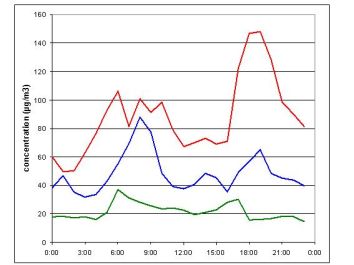|
|
 |
Health effect of particles
Each time we inspire, around 0.5 litres of air penetrate in our lungs, bringing oxygen to our body. But as the atmosphere contains also thousands of particles, we also breathe that particulate matter. It can be bad for the health, depending on the size and composition of particles. Centuries before pollution begins to pose a health hazard, men and women could already have respiratory problems due to their activities.
|
|
Historical signs
In 1555, the Danish bishop Olaus Magnus said that the farmers should thresh hay against the wind “because the dust is so fine that one can not notice its inhalation and accumulation in back of the throat”. Even then, the effect of particles on human health had been noticed.
During the next centuries and the industrial revolution, workers were exposed to dangerous particulate matter: in 1800s, lung disease became a major problem for coal miners, particularly in Great Britain, mining much of the world’s coal.
|
 |
 |
1. Coal miners at the beginning of the 20th century in center of France. Source:www.icilacreuse.com. |
|
 |
 |
 |
2. Cotton workers at Dean Mills near Manchester in 1851. Source: The Illustrated London News. |
|
|
Nowadays in many countries people are still working in poor conditions. Effects of particles are still a problem, especially for employees exposed to dust, like construction workers, bakers, farmers...
|
|
Links between particles and health
Scientific studies have shown that an increase in particle air pollution leads to an increase in respiratory problems like asthma and bronchitis. Emergency admissions and hospitalization for respiratory disorders increase during a rise in the particles concentration. Furthermore, people that breathe high concentration of particles during years (called long-term exposure) are more likely to develop lung cancer.
|
 |
 |
|
3. You can see here the concentration of particles versus time of the day. Red lines are measurements in a busy street in Paris, whereas blue lines are measurements in an area inside Paris. Green lines are particles measured in a rural zone. All measurements were performed on September 16, 2003. Look at how concentrations are greater when people go to work in the morning and come back home at the end of the afternoon, due to vehicles emissions. Click to enlarge! (30 K).
Source: Airparif.
|
|
 |
Values in cities
As particles are dangerous for the health, European community has decided to specify air quality standards. The level of particles that should not be exceeded on average during one year is 44.8 µg/m3. It means that in a volume of air of 1 m3, if we weight tiny particles, the mass shouldn't exceed this value.
As a matter of fact, there is no threshold below which particles concentration has no effect on health.
The value of 100 µg/m3 is often exceeded in European cities during the day. |
|
Toxicity of particles depends mainly on their size and chemical composition.
The smallest a particle is, the deeper in the respiratory system it will penetrate.
For more details on the respiratory system and the effect of particles according to their sizes, see the "more" chapter...
|
About this page...
Author: J. Gourdeau, LAMP Clermont-ferrand, France. Scientific reviewing: Dr Serge Despiau, LEPI, Toulon, France.
Date of generation: 2003-10-14. |
|
 |
|









